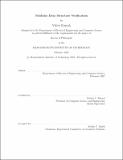| dc.contributor.advisor | Martin C. Rinard. | en_US |
| dc.contributor.author | Kuncak, Viktor (Viktor Jaroslav), 1977- | en_US |
| dc.contributor.other | Massachusetts Institute of Technology. Dept. of Electrical Engineering and Computer Science. | en_US |
| dc.date.accessioned | 2007-08-29T19:06:53Z | |
| dc.date.available | 2007-08-29T19:06:53Z | |
| dc.date.copyright | 2007 | en_US |
| dc.date.issued | 2007 | en_US |
| dc.identifier.uri | http://hdl.handle.net/1721.1/38533 | |
| dc.description | Thesis (Ph. D.)--Massachusetts Institute of Technology, Dept. of Electrical Engineering and Computer Science, 2007. | en_US |
| dc.description | This electronic version was submitted by the student author. The certified thesis is available in the Institute Archives and Special Collections. | en_US |
| dc.description | Includes bibliographical references (p. 149-166). | en_US |
| dc.description.abstract | This dissertation describes an approach for automatically verifying data structures, focusing on techniques for automatically proving formulas that arise in such verification. I have implemented this approach with my colleagues in a verification system called Jahob. Jahob verifies properties of Java programs with dynamically allocated data structures. Developers write Jahob specifications in classical higher-order logic (HOL); Jahob reduces the verification problem to deciding the validity of HOL formulas. I present a new method for proving HOL formulas by combining automated reasoning techniques. My method consists of 1) splitting formulas into individual HOL conjuncts, 2) soundly approximating each HOL conjunct with a formula in a more tractable fragment and 3) proving the resulting approximation using a decision procedure or a theorem prover. I present three concrete logics; for each logic I show how to use it to approximate HOL formulas, and how to decide the validity of formulas in this logic. First, I present an approximation of HOL based on a translation to first-order logic, which enables the use of existing resolution-based theorem provers. Second, I present an approximation of HOL based on field constraint analysis, a new technique that enables decision procedures for special classes of graphs (such as monadic second-order logic over trees) to be applied to arbitrary graphs. | en_US |
| dc.description.abstract | (cont.) Third, I present an approximation using Boolean Algebra with Presburger Arithmetic (BAPA), a logic that combines reasoning about sets of elements with reasoning about cardinalities of sets. BAPA can express relationships between sizes of data structures and invariants that correlate data structure size with integer variables. I present the first implementation of a BAPA decision procedure, and establish the exact complexity bounds for BAPA and quantifier-free BAPA. Together, these techniques enabled Jahob to modularly and automatically verify data structure implementations based on singly and doubly-linked lists, trees with parent pointers, priority queues, and hash tables. In particular, Jahob was able to prove that data structure implementations satisfy their specifications, maintain key data structure invariants expressed in a rich logical notation, and never produce run-time errors such as null dereferences or out of bounds accesses. | en_US |
| dc.description.statementofresponsibility | by Viktor Kuncak. | en_US |
| dc.format.extent | 166 p. | en_US |
| dc.language.iso | eng | en_US |
| dc.publisher | Massachusetts Institute of Technology | en_US |
| dc.rights | M.I.T. theses are protected by copyright. They may be viewed from this source for any purpose, but reproduction or distribution in any format is prohibited without written permission. See provided URL for inquiries about permission. | en_US |
| dc.rights.uri | http://dspace.mit.edu/handle/1721.1/7582 | |
| dc.subject | Electrical Engineering and Computer Science. | en_US |
| dc.title | Modular data structure verification | en_US |
| dc.type | Thesis | en_US |
| dc.description.degree | Ph.D. | en_US |
| dc.contributor.department | Massachusetts Institute of Technology. Department of Electrical Engineering and Computer Science | |
| dc.identifier.oclc | 164875057 | en_US |
